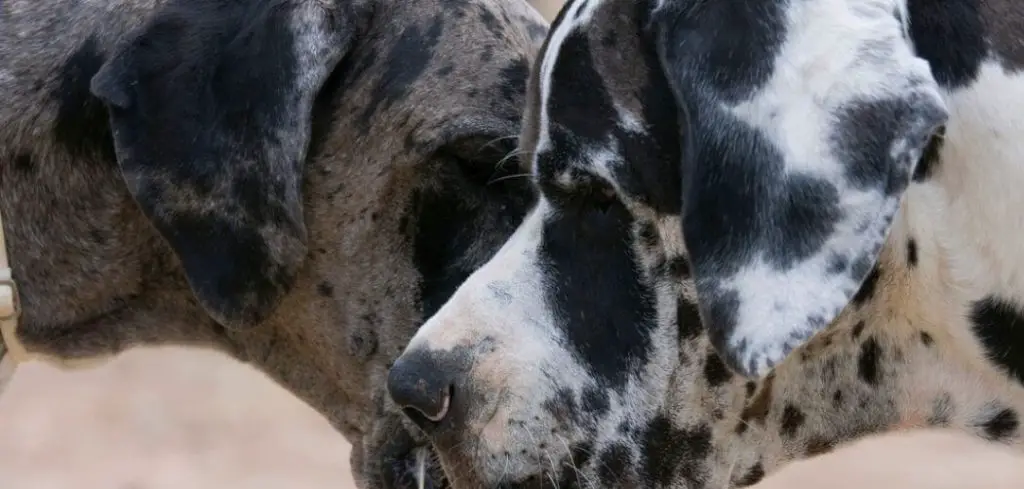If your dog is constantly licking another dog, it might seem like a harmless or even affectionate behavior—but excessive licking can point to deeper issues.
Whether it’s focused on the other dog’s ears, face, or paws, this repetitive action may stem from anxiety, dominance, grooming instincts, or even a sign of an underlying medical concern in the licked dog.
We outline the common causes of a dog excessively licking another dog, what you can do at home, and when to seek veterinary help.
Table of Contents
Dog Excessively Licking Other Dog — Why It Happens
When a dog constantly licks another dog, it may indicate social bonding, dominance, anxiety, medical issues, or even compulsive disorders. While occasional licking is normal in canine interaction, excessive licking can signal an underlying emotional or physical problem that requires attention.
It can also lead to problems if the recipient dog becomes irritated, develops skin infections, or starts to avoid the licker.
Recognizing when this behavior crosses the line from cute to concerning is key to managing it.

Common Causes of Dog Excessively Licking Other Dog
Social Bonding
Dogs are pack animals that often lick each other to reinforce social bonds. This is especially common in dogs that live together or have grown up together.
Licking can be a sign of affection and submission. The licking dog might be demonstrating deference, love, or respect to the other dog.
However, if the behavior becomes obsessive, it could indicate anxiety or lack of proper stimulation, rather than pure affection.
Read more: Dog Excessively Licking Privates (What’s normal vs. what’s not?)
Anxiety or Insecurity
Anxious dogs may turn to excessive licking as a self-soothing behavior. When directed at another dog, it may be their way of seeking comfort or reassurance.
Changes in the household, separation anxiety, or the introduction of a new pet can all trigger this kind of licking.
You might notice pacing, whining, or following the other dog constantly along with the licking.
Medical Issues in the Other Dog
Sometimes, dogs will lick another dog’s specific body part if there’s a wound, infection, or abnormal scent that draws their attention.
If your dog is fixated on licking one spot on the other dog, inspect that area. It could be a hotspot, rash, joint pain, or something more serious like a tumor.
This type of licking may be persistent and localized, and it’s important not to ignore it.
Dominance or Habitual Behavior
Licking can also be a way for one dog to exert control or dominance over another, though it’s less common than other dominance signals.
In some cases, what starts as playful or nurturing behavior becomes a habit that continues out of routine, even when it’s no longer appropriate.
This can lead to tension between dogs if the recipient doesn’t enjoy being licked constantly.
Compulsive Disorder
In rare cases, excessive licking—whether directed at themselves or others—can become compulsive.
Compulsive behaviors in dogs often arise from stress, boredom, or lack of proper outlets for their energy.
The licking may seem nonstop, even when the other dog moves away, and it might persist in other forms such as licking furniture or humans.
What to Do If Your Dog Is Excessively Licking Another Dog
First, try to determine the context of the licking. Is it occasional and affectionate, or is it constant and causing tension?
Redirect your dog with toys, puzzles, or a command when you see the behavior start. Praise them for stopping and engaging with something else.
Ensure both dogs are getting enough physical and mental exercise. Boredom is a common cause of obsessive behaviors.
Look for medical issues in the dog being licked. If your dog is licking a certain area repeatedly, inspect it or visit your vet for a check-up.
Use crate time or temporary separation if necessary to reduce stress and interrupt the cycle, but don’t punish the licking dog harshly—this can make anxiety worse.
When to Call or Visit Your Vet
If the licking behavior is constant and interfering with both dogs’ well-being, it’s time to speak to your vet.
Check for skin infections, sores, or irritations on the dog being licked. Open wounds or hair loss are red flags.
If your dog becomes obsessive, anxious, or shows other signs of compulsive behavior, a veterinary behaviorist may be needed.
Behavior that suddenly appears or worsens after a major change at home could also be a sign your dog is struggling emotionally or physically.
Don’t ignore signs like aggression, avoidance, or vocalization from the dog being licked—they may be trying to say, “Enough is enough.”
Read more: Dog Excessively Farting (Is it just diet or something serious?)
Key Takeaway
Excessive licking between dogs isn’t always a problem—but when it crosses into obsessive or disruptive behavior, it’s important to pay attention.
Whether it’s a sign of affection, anxiety, dominance, or a reaction to a medical issue, identifying the cause is the first step to resolving it.
With proper observation, redirection, and—if needed—veterinary help, you can restore harmony and keep both dogs happy and healthy.
